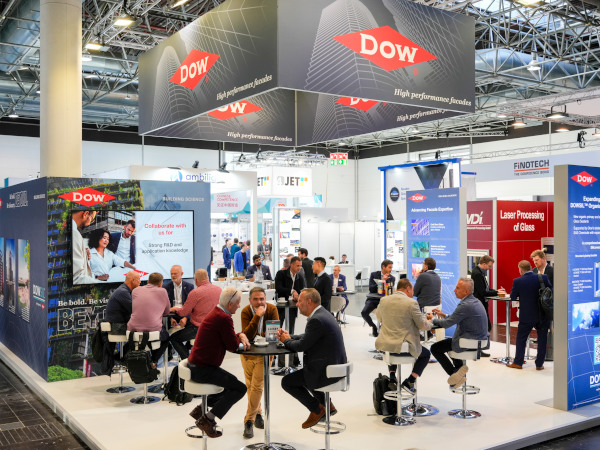Date: 2 October 2015
At the new location of Ensinger Sintimid in Austria, this look was used to create a special ambience in the entrance area: By creating a quarter turn, the glazed facade entices guests into the building, which sports a white and silver grey theme in keeping with the global company's corporate design colours."The linear contours which are a distinguishing feature of the building in Seewalchen have been deliberately softened in the entrance area" explains Michael Frey, the CEO of Architects Schmelzle + Partner."In terms of styling, this has created a curve linking the world of sophisticated high technology and the people whose special expertise in high-performance plastics is used here to develop specially tailored solutions for customers."
.png)
The required bending radius is produced simply and precisely without any folds using a manual roll former.
Bending the rules
The curved facade elements were produced by Wenna Glass in Linz. Every pane measuring 2,126 mm in length and between 845 and 1,940 mm in height was precisely curved to the required radius of 2,635 mm using a special hot bending technique. But there was a question mark over the process from the start: How to further process the Thermix brand warm edge spacers specified by the client to fit the triple insulating glass? Although these spacers can be bent when cold to produce frames, they are considered "rigid" as they have been used to date predominantly for flat insulating glass.
Ensinger itself came up with some expert advice. After all, the German sister company has been producing and further developing Thermix since 1994. "We checked this using a simple bending process", explains application engineering specialist Heinz Raunest. "It's actually sufficient to use a good manual roll former. With a few minor adjustments the plastic profiles can be precisely adapted to the required radius without any folds. The material with its integrated stabilizing wires stays reliably in shape."
.png)
The pre-bent spacers are filled with desiccant, fitted manually with butyl tape and then assembled to produce frames using corner keys.
Simply adjustable
"We were able to then fill the pre-bent profiles in the customary way using adsorbent, apply butyl tape and assemble them to form frames using corner keys", adds Christoph Wenna, Business Development Manager at the curved insulating glass specialist. "We then built up the triple glazed units from the inside out, pressed the elements using clamps, filled them with inert gas and sealed them. It was all amazingly simple, as the glass and spacers had been processed to a high degree of precision."
The job of the installers from Mglass Objektbau in Steyregg was somewhat more fraught with difficulty: With the aid of a crane, they fitted the ten weighty elements into the supporting structure of the facade and anchored them in place into their frames with plaster strips and rolled aluminium trims. Robert Kaiser, Head of Controlling and authorized signatory at Ensinger Sintimid, is delighted with the new building. After only twelve months of construction, the company was able to move into the building on schedule.
.jpg)
Using the spacer frames, the triple insulating glass is built up in layers from inside to out, pressed together and the gaps between the panes filled with argon.
Energy-efficient construction
Overall, Ensinger Sintimid has invested over 5 million € in its Seewalchen location, setting a course for further growth. A workforce of around 40 currently handles and produces semi-finished products, finished parts and compounds made of high-performance plastics, which are used in a wide range of industries the world over, in particular in the aerospace sector, in electronics and semi-conductor production, mechanical engineering and the automotive industry.
.png)
The gas valve is closed and the insulated glass assembly is sealed using a secondary sealant.
"We now have twice as much space available as before. Thanks to the energy-efficient construction method used, we also anticipate a significant reduction in operating costs per square metre", says Robert Kaiser. "Heat pumps enable surplus heat from production to be used for heating. The facade is highly insulating, with the flat and curved triple ISO elements providing a thermal transmission coefficient of just 0.89 W/m2K. This new building really does have all-round benefits for Ensinger, for the workforce, the customers and also the environment."

The curved facade elements made of triple insulating glass are lifted with the aid of a crane and placed in position from the raised platform.

The precisely fitted insulating glass elements are then permanently connected to the supporting sub-construction using aluminium trims.
Facts and figures
Project location: Ensinger Sintimid GmbH, Ensinger Platz 1, 4863 Seewalchen, Austria
Plot: 12,000 square metres
Utilization: 3081 sq.m. for production and warehouse, two floors of 722 sq.m. for administration, Scope for optional building extension.
Special features: Modern architecture in keeping with the global corporate design, process-optimized building planning, energy-efficient construction: Heat pumps use surplus heat from production for heating, highly insulating facades, triple insulating glazing in the administrative wing with Thermix TX.N plus Warm Edge spacers even in the curved part of the glass facade.
Investment volume: Around 5 million Euro
Construction period: May 2014 to June 2015
Client: Ensinger Sintimid GmbH, Seewalchen, Austria
Architect: Schmelzle + Partner GmbH, Hallwangen, Germany
General contractor: Goldbeck Rhomberg GmbH, Salzburg, Austria
Curved windows: Wenna Glas GmbH, Linz, Austria
Warm edge: Thermix, Ensinger GmbH, Ravensburg, Germany
Facade construction: Mglass GmbH, Steyregg, Austria









Add new comment